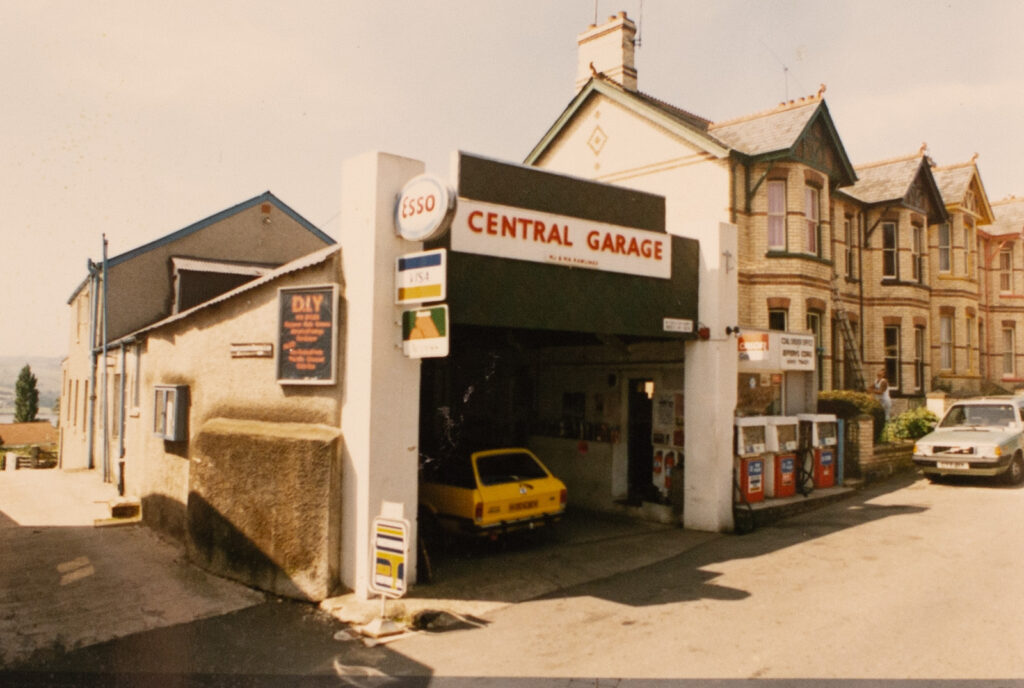
Central Garage
One of the most interesting buildings in Fore Street, not particularly known for its shape or beauty, but more so for its historic standing, is the property that has for some time carried the name of Central Garage.
The building has changed little over the years. It was built in the 1790’s to house and care for the horses and carriages belonging to the estate known as Keittoes (later known as ‘Kittoes’) in Fore Street. The frontage was originally an arch shape, that is now squared, the front door has changed and electricity was introduced.
The one thing that has been a constant through the centuries and up to the present day is Transport. From its early days of horses and carriages, through the decades of various owners, the building has continually been used to care for and maintain all types of horse drawn and motorised vehicles. Until the end of the 1960’s the rear of the building, at the workshop end, still had the old cobbled stable flooring.
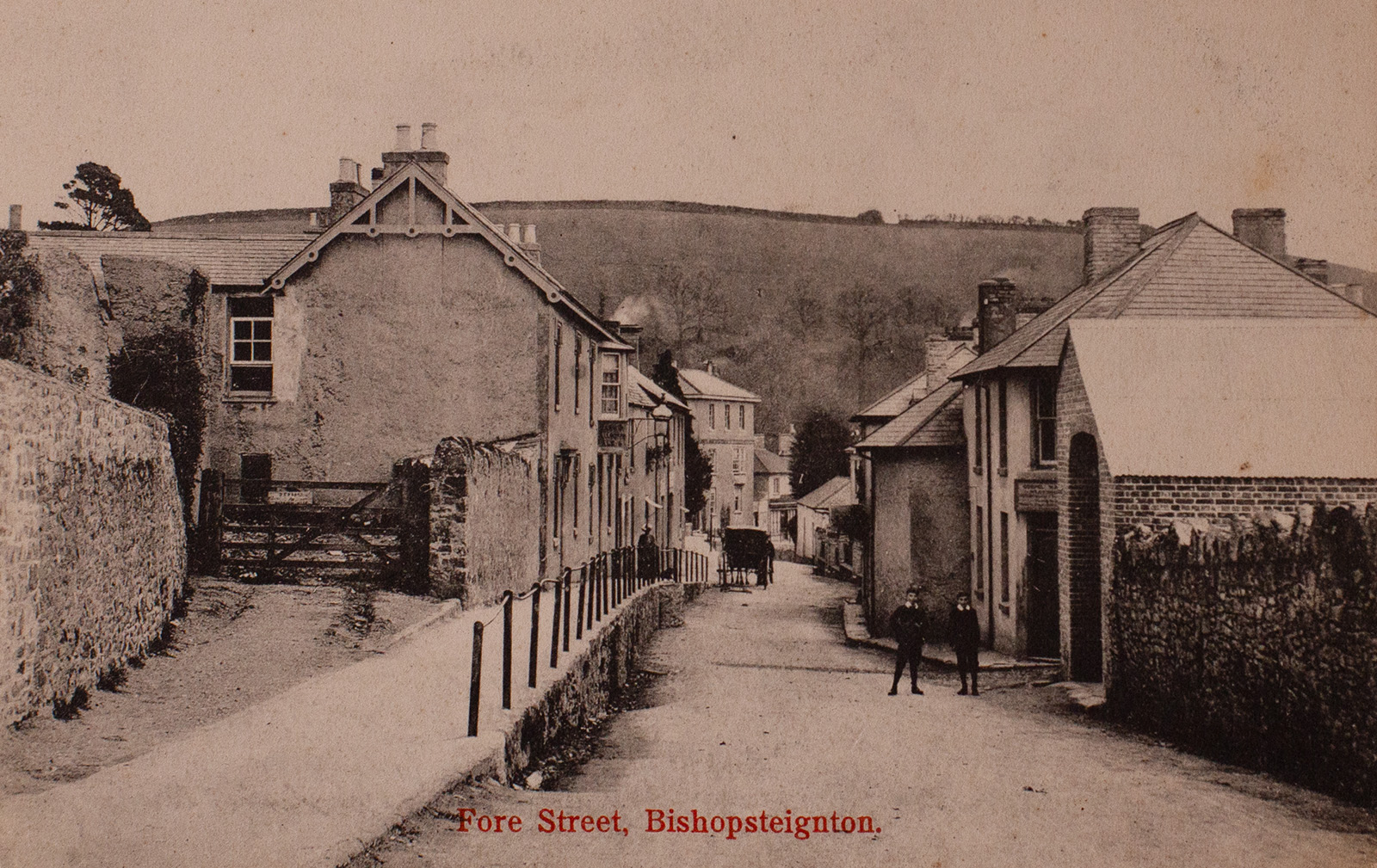
Harvey’s Garage (now known as Central Garage) on Fore Street.
As a Coach house with an adjoining paddock, it was part of the Keittoes estate. Where the terrace houses, (River View Terrace), now stand, was Keittoes garden nursery and adjoining plantation for the private use of the estate.
There was an auction sale held in 1869 arranged by head gardener Mr Stamp on behalf of Michael L Brown, owner of Keittoes, offering 122 choice varieties of Alocasia: Begonia: Sansevieria: Spiralis: Fern: Azealia: 4 lemon, 1 orange and 1 fig tree: 33 Camillas: 138 Fuchsias: 369 Geraniums: 7 choice vines and 26 potted roses:
The land on which the nursery stood was offered for sale in 1895 as suitable for building but not sold at that time.
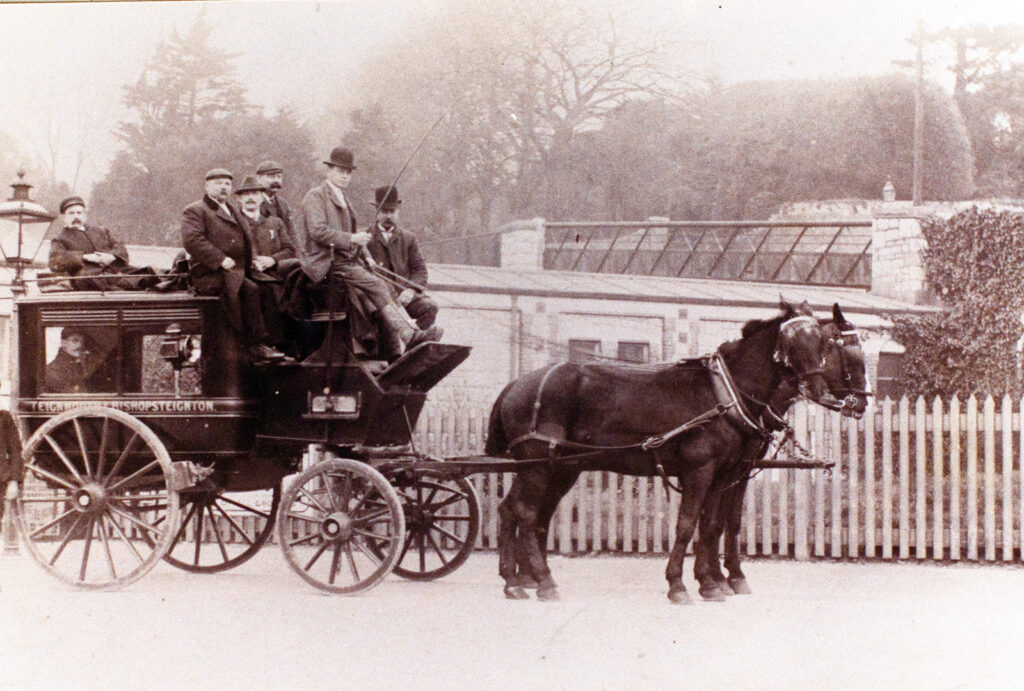
The Bishopsteignton -Teignmouth Horse Bus
Arthur George Harvey, the eldest son of Richard & Mary Harvey, Farmers of Higher Radway Farm, lived with his wife Mary and daughter Phyllis in “Sunnyside” Fore Street, (two doors down from the Manor Inn).
On becoming the tenant of the property known as ‘Keittoes Coach House’ which included a portion of the adjoining land, Arthur Harvey became the first independent proprietor of the workshop & coach care section of the building. He was a Cab Proprietor, (horse drawn), and then a Carriage Proprietor, the business became known as Harvey’s Coach House.
In 1897 Mr Harvey purchased the previously rented ‘Coach House’ complete with the adjoining land known as ‘Cooks Door Field’.
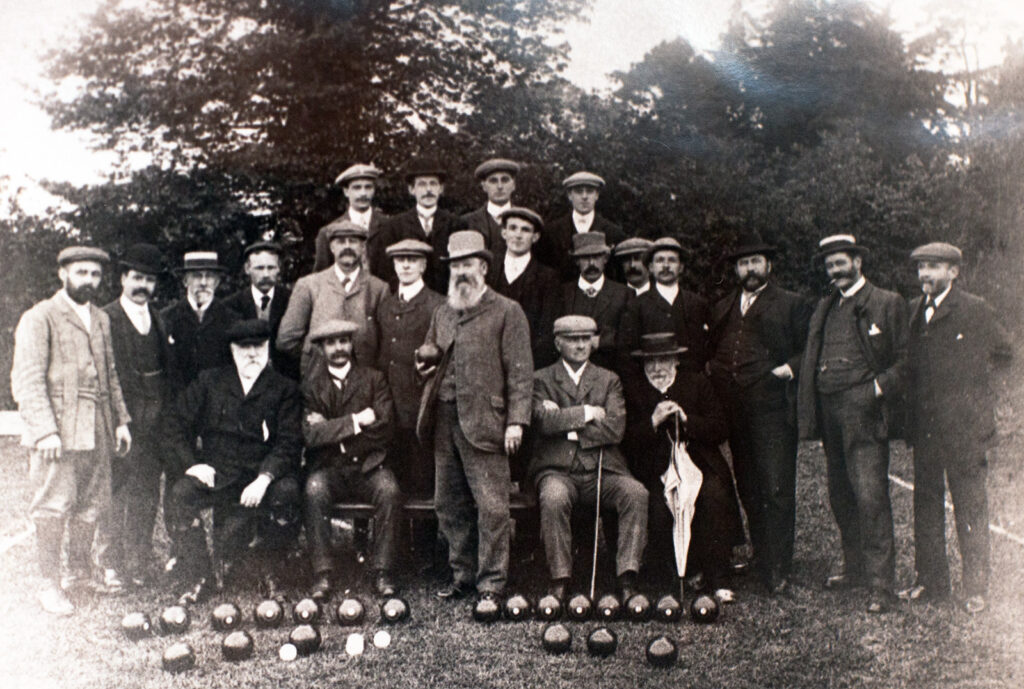
Arthur Harvey, Owner of Central Garage, who sat down is second from the left
In 1909 the New Bowling Green was opened on land adjoining the rear of the Coach House with access from Fore Street, using the lane at the side. The Bowls Lawn remained in use for around 90 years.
The first main change to the building was in 1910, with the development of the first-floor loft and groom’s room into the “Unionist Club House” This made a large area to be used for Billiards, Bagatelle and other games, and for meetings and social functions.
The cost of the alterations was about £80, all of which had been collected in the village. The first chairman for the new club was Mr Lewis M Brown of Keittoes, the treasurer, Mr Willam Discombe of Wolfsgrove and honorary secretary Mr David Pook of Belle Vue.
It was opened by Mrs Morrison-Bell, wife of the then Unionist candidate, she was presented with a silver key to commemorate the day. A public tea followed in the club at which over 200 sat down with Lord Clifford of Chudleigh presiding.
The club closed in 1915 for the duration of the first world war and was re-opened in 1926 by Harry G Younger of the Scottish brewery family, who is the new owner of Kittoes.
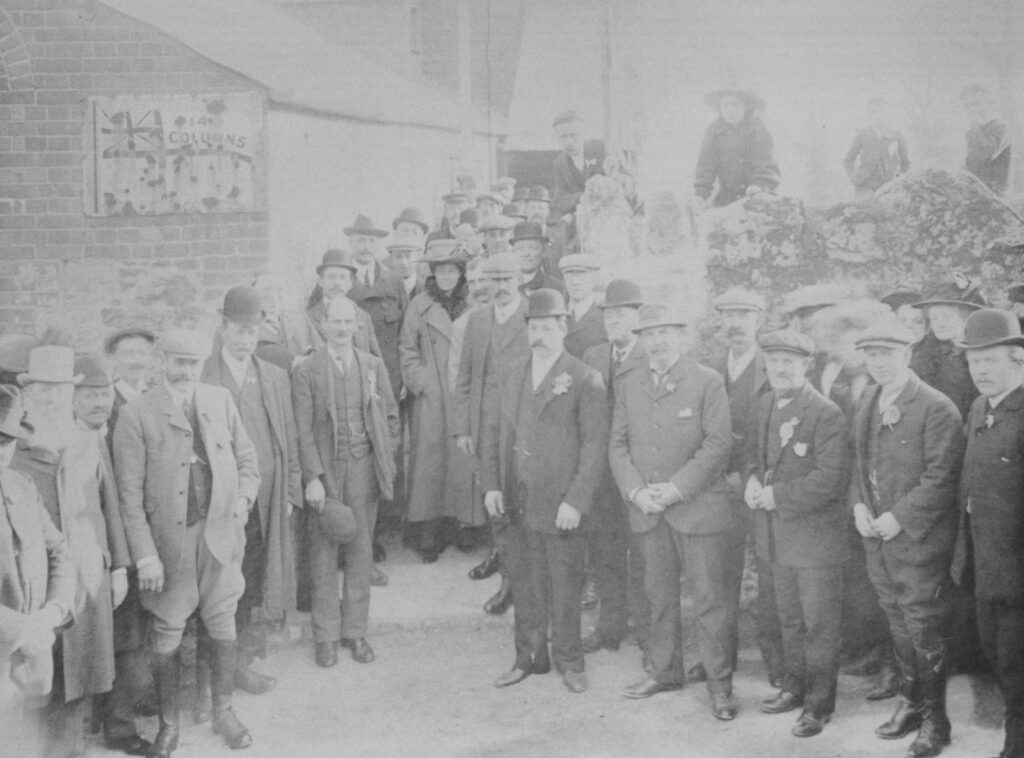
Opening of the Unionist Club pre 1910
Following its re-opening, many social events took place in the new club including the 1937 wedding reception of John (Jack) Ward and Catherine (Kit) Dennis, popular owners of the butcher’s shop in Fore Street.
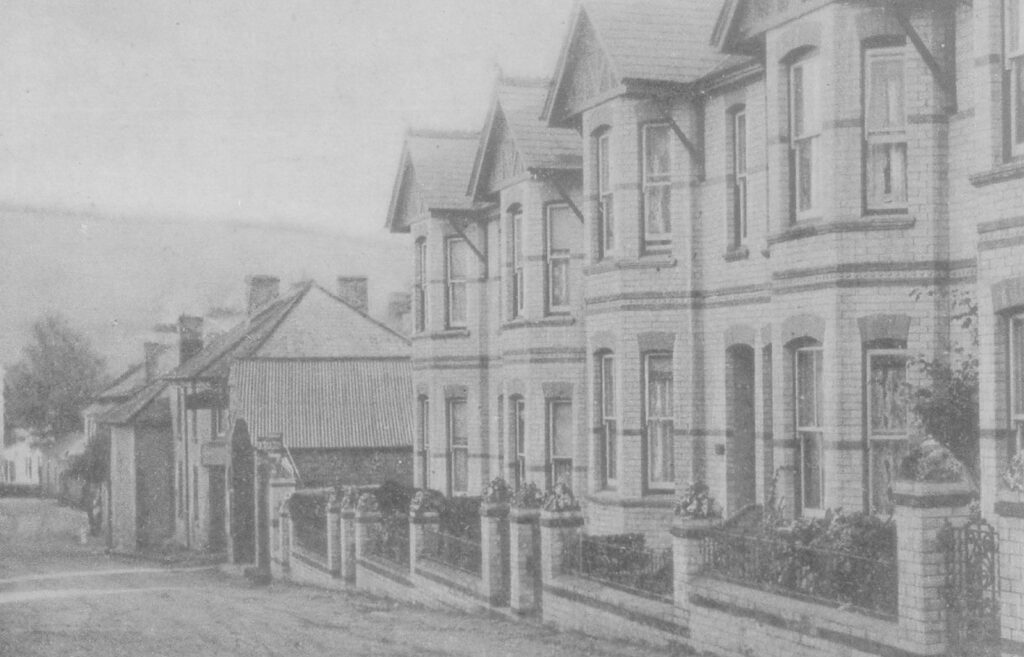
River View Terrace, Bishopsteignton
Around 1910 Mr Harvey commissioned the building of 6 houses (known as River View Terrace), on the land next to the garage. The first four were built and occupied before the final two, nearest the village hall, were built. Mr Harvey, his wife and daughter, moved into No 6 which they named “St Albans”.
The arched frontage to the garage building, still remained at that time.
By 1921, Mr Harvey had developed the business and is recorded as being a Car & Bus Proprietor. He ran a bus service from the premises in Fore Street. One of his drivers at the time was Irwin Down who lodged with Samuel & Dassya (pronounced Dessa) Taylor. It was during Mr Harvey’s ownership that a petrol, oil and paraffin service was introduced.
By 1932 Mr Harvey decided to retire and the new Garage and Car proprietor was Samuel (Sam) Taylor. Sam, born 1885 started life in Ashwell cottages before the family moved to Mount Radford on Smith Hill.
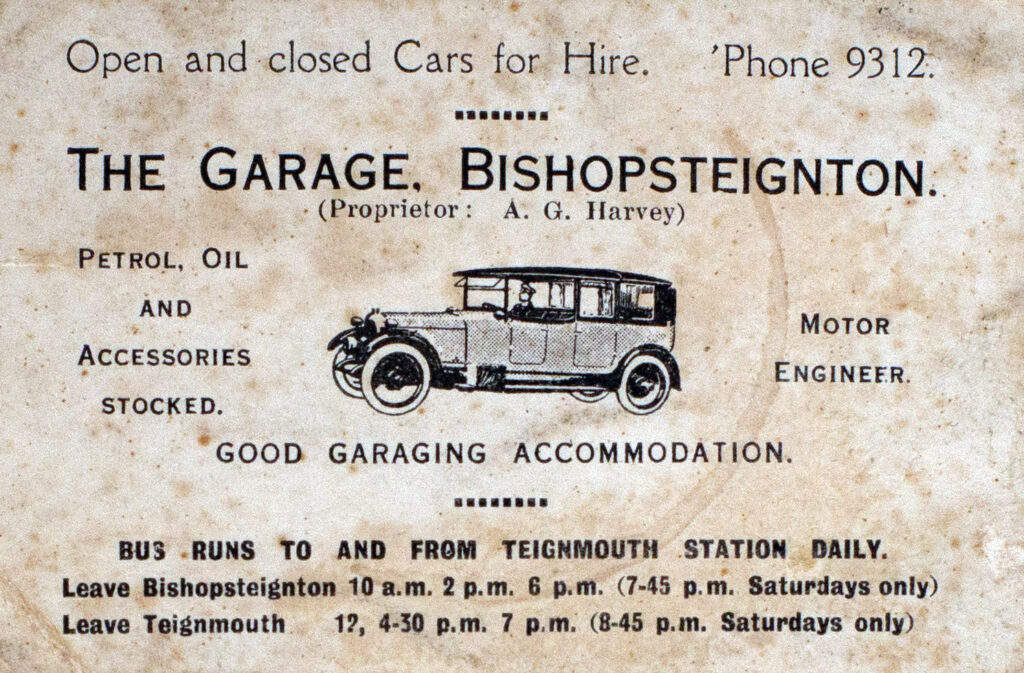
Business Card for A G Harveys Bus and Car Hire Service
In 1908, Sam married Dassya Brooke and they set up home at number 8 The Terrace, Teign View Road. They then moved to Lower Post Office Street, (Fore Street). At this time Sam was working for Farmer Discombe as a Tractor Driver and was also the driver of the Steam Thresher.
In taking over the garage Sam became bus proprietor and carrier. The spacious garage offered repairs, Petrol with Shell and BP pumps, Shell and Wakefield Oils, Tyres and Accessories. At the same time as taking over the garage business, Uncle Sam and Aunt Dessa, as we children knew them, bought Mr Harvey’s old home “Sunnyside” near the Manor Inn, Fore Street. It was here that they adopted their only child, a son called Clifford.
Sadly, on 7th October 1946 Their son Clifford was killed on his motorbike at ‘Salcombe Dip’ on the Teignmouth Road, together with his friend Robert Mann of Shute Farm, (both 16 years old), as they returned from an ATC class at Teignmouth. It was soon after this that Uncle Sam gave up the garage business and retired.
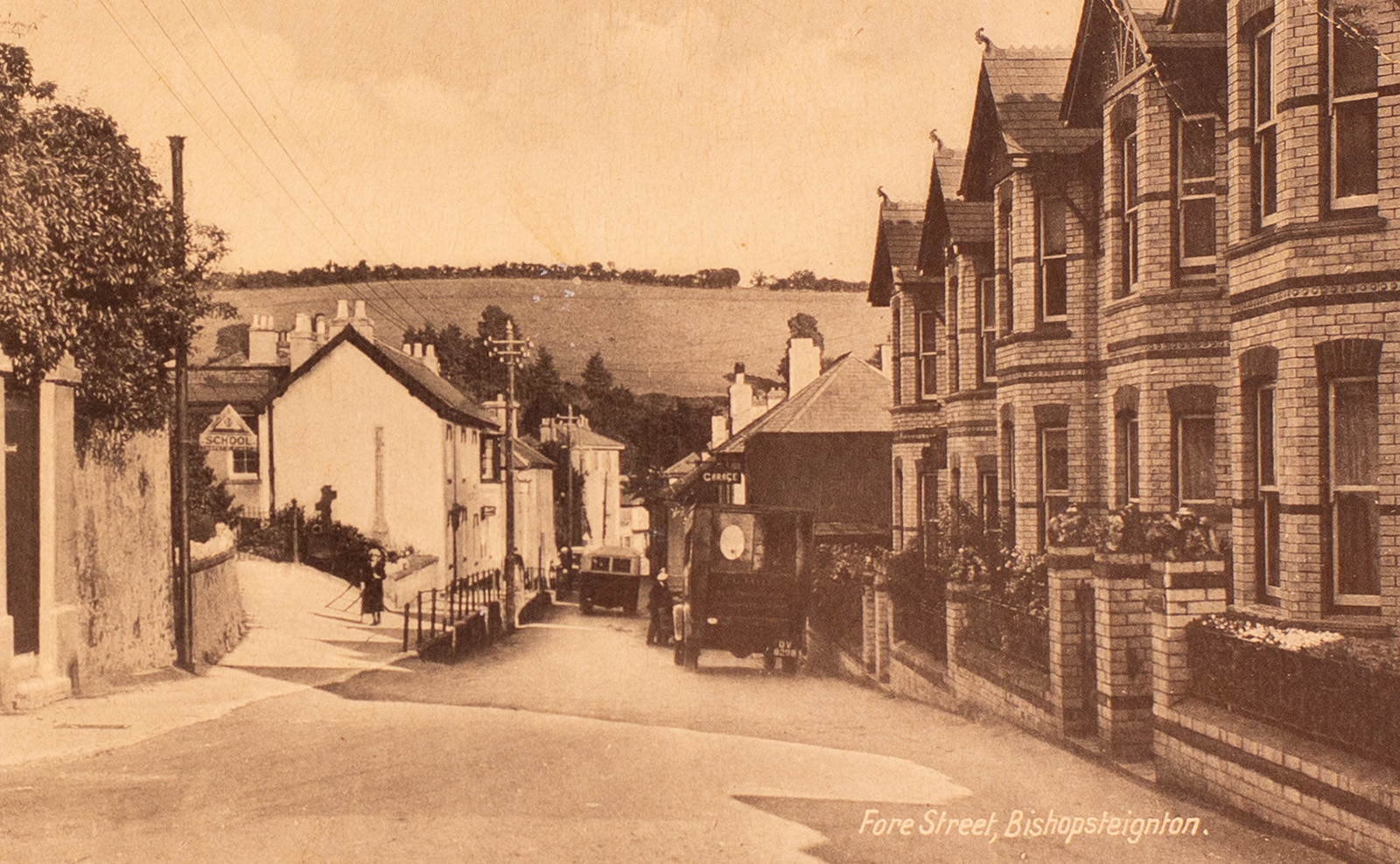
Inscription on the back reads: ‘Fore Street in 1928, Samuel George Taylor owned the Central Garage until Malcolm and Margaret Rawlings took it over in 1966. Mr Taylor’s bus stands at the garage’.
Aunt Dessa continued to run “Sunnyside” as apartments and a small bed and breakfast guest house and for several years her front room was used once or twice a week as the Doctor’s surgery with Dr Kelly visiting from Teignmouth. When she retired, the couple moved and lived out the rest of their days in the much smaller cottage next door, then called “Cozy Cott”. Sam and Dessa were both exceptional Bowls players and long-standing supporters of Bishopsteignton Bowling Club.
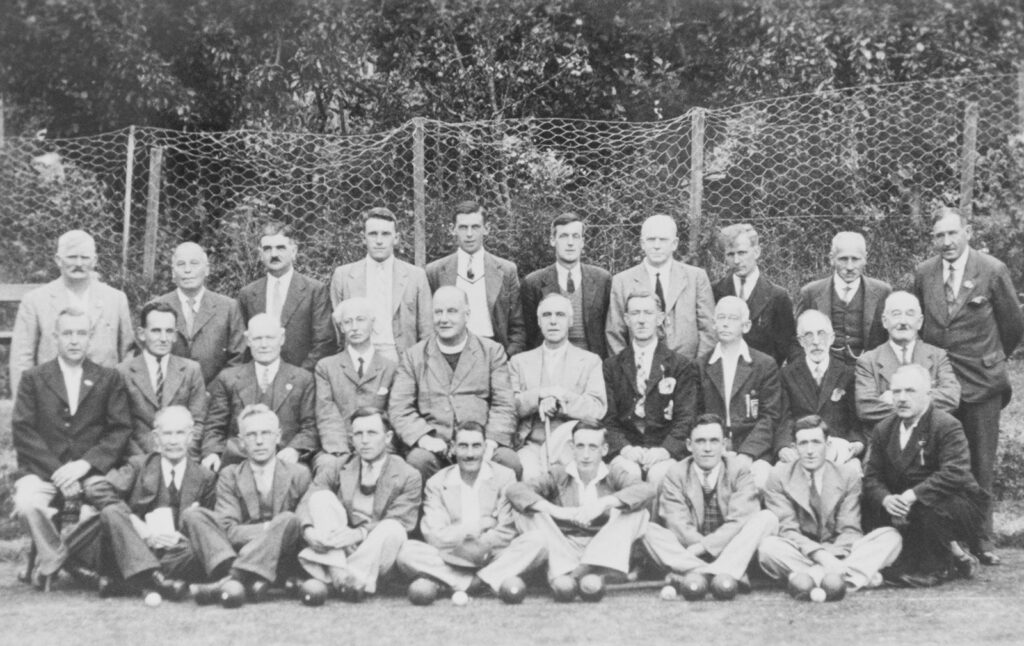
Bishopsteignton Bowling Club pre WWII including Sam Taylor (bottom row right kneeling) who was the owner of Central Garage 1939.
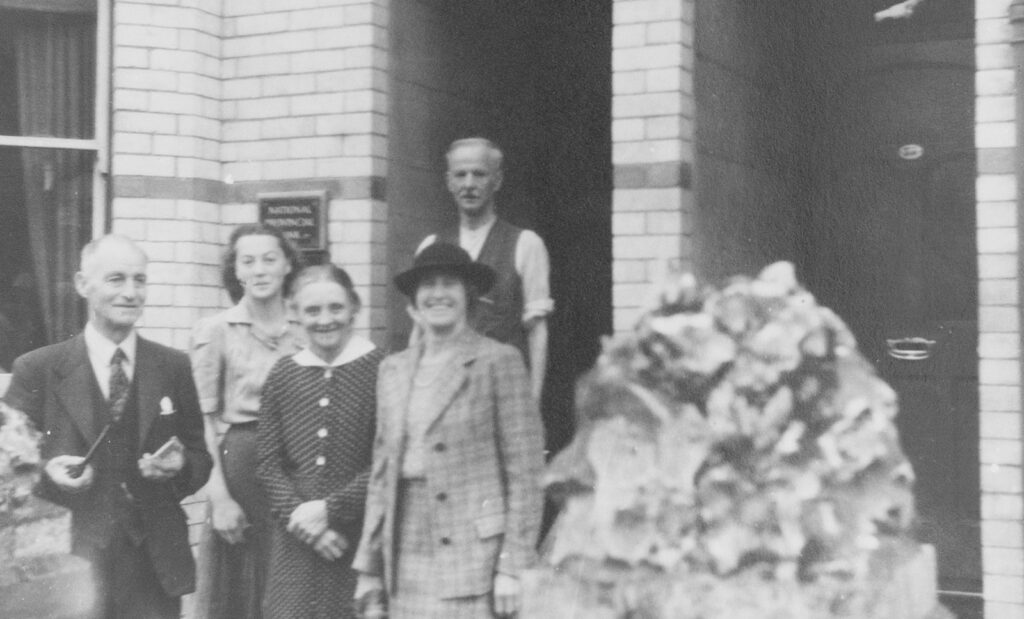
Sheila Robbins and her family outside 37 Fore Street beside Central Garage.
In her Heritage Hub interview, Sheila Robbins (nee Skinner) whose parents and siblings lived next to the garage, shared memories of her older brother Sidney, and herself being woken during wartime by the rumble of trucks and leaning out of the window to witness columns of men, many wrapped in blankets, ascending the stairs to the Unionist Club above the neighbouring garage. These men, were some of the survivors of the small boat evacuation of the Dunkirk beaches. Her mother spent the rest of the night making pot after pot of tea for the troops.
Not long after the end of the second world war the Unionist club closed and the space was eventually developed into the garage owner’s three bedroomed flat.
In 1949 Sidney George Victor (Sid) Davey became the new proprietor of the garage, now renamed “Davey’s Garage”. Sid was born in Kingsteignton and moved to Bishopsteignton soon after his marriage to Dorothy Walling. In the 1939 census they are recorded as living at “Marland”, near Colway Cross. At this time Sid worked as a Motor and Electrical Mechanic.
Together with their son also called Sidney they moved to 50 Fore Street, (where the post office & pharmacy are now), Sid ran a small motorbike and bicycle repair shop. Sid and his son, were big supporters and participants of Bishopsteignton Cycle Speedway Club.
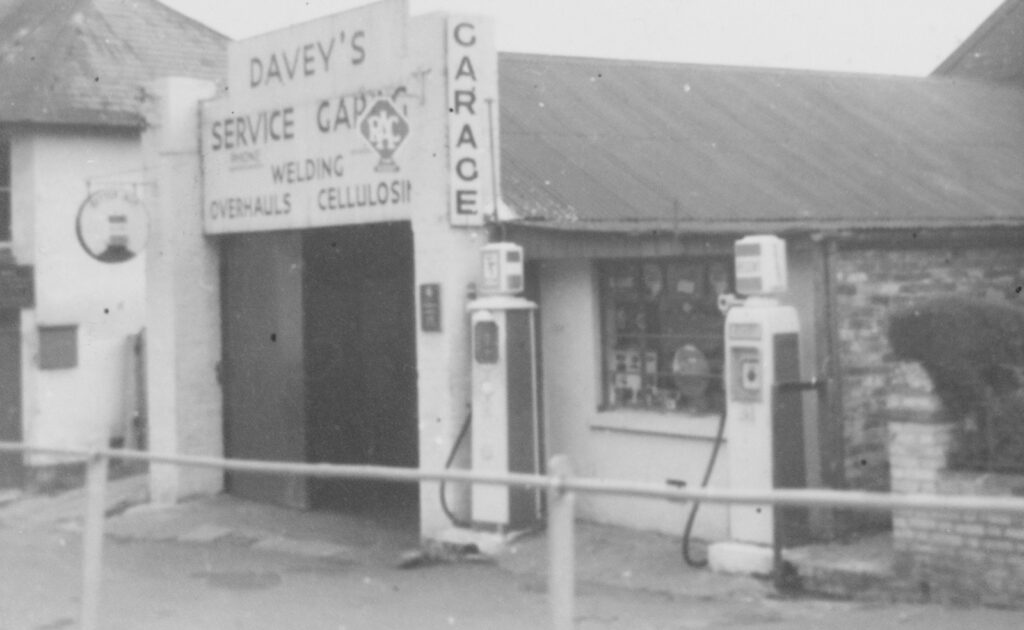
Davey’s Garage, Bishopsteignton
A report in 1950 covered a match between Bishopsteignton ‘Aces’ and Combeinteignhead ‘Lions’ taking place at ‘Puner track’ with plenty of thrills and spills. Outstanding riders were named as Steve Shambrook and Sid Davey of Bishopsteignton.
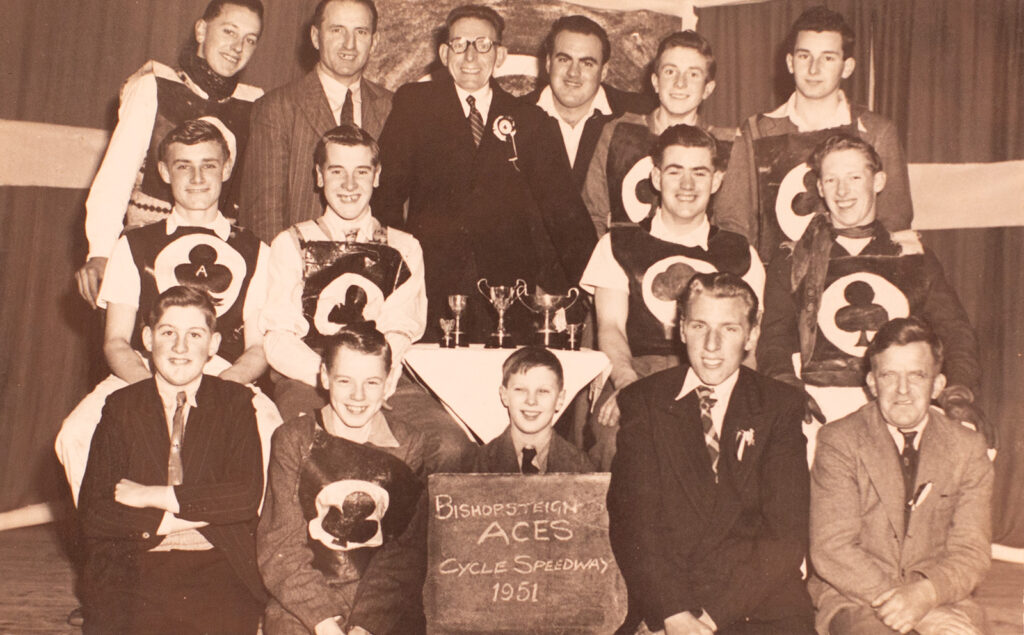
Members of the Aces Cycle Speedway
John (Jack) Aldridge, started working for Sid Davey on 1st October 1949 as a fitter and driver. Jack was married to Sylvia of the Ward family, who for many years had carried out the trade of butchers at the nearby shop in Fore Street. While employed at the garage, Jack and Sylvia lived in the flat above the garage, where their first two children Gary and Jane were born.
Early In 1955 William (Bill) Lavender, a motor engineer and his wife Daisy, moved from South Tawton, north of Dartmoor, to take over the establishment, re-named ‘Central Garage’ together with business partner Amy Arscott, sister to Daisy. They lived above the garage and are believed to have been the first owners to live there. It was at this time that Alan Heard, a car mechanic, from Cockhaven Road, came to work at the garage.
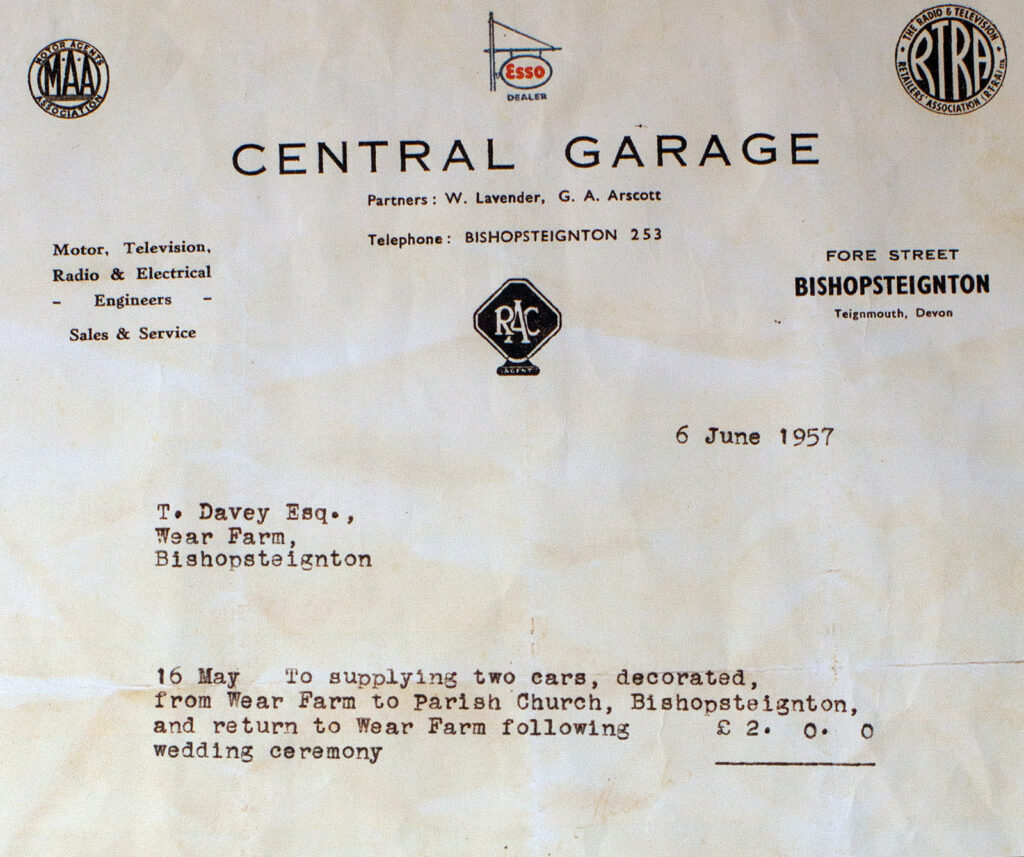
Invoice with reference to the Central Garage
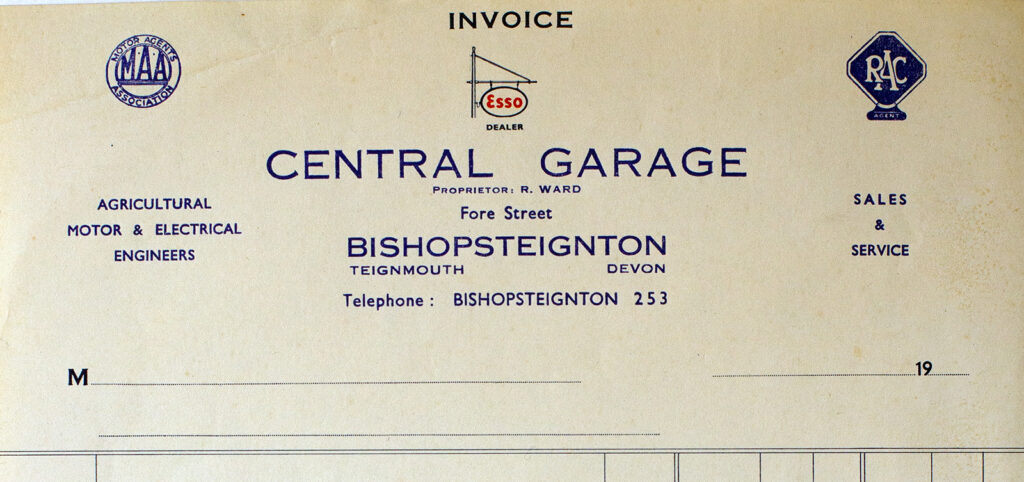
Central Garage Headed Paper
They brought with them a World War Two, GUY British armoured car. On the bonnet was a brass symbol of a ‘Red Indian’ in full headdress. Bill had used the vehicle to deliver paraffin in rural areas when living in South Tawton. He never used it in Bishopsteignton but it could be seen in all its glory, parked at the back of the garage. In 1955, Bill bought a beautiful black Humber Super Snipe affectionally called NODDY after its number plate NOD 317. It was used for funerals, weddings and upmarket taxi work. It did about 15 miles to the gallon. At this time the garage sold Esso petrol, Castrol oils as well as other new products such as Redex Fuel Additive.
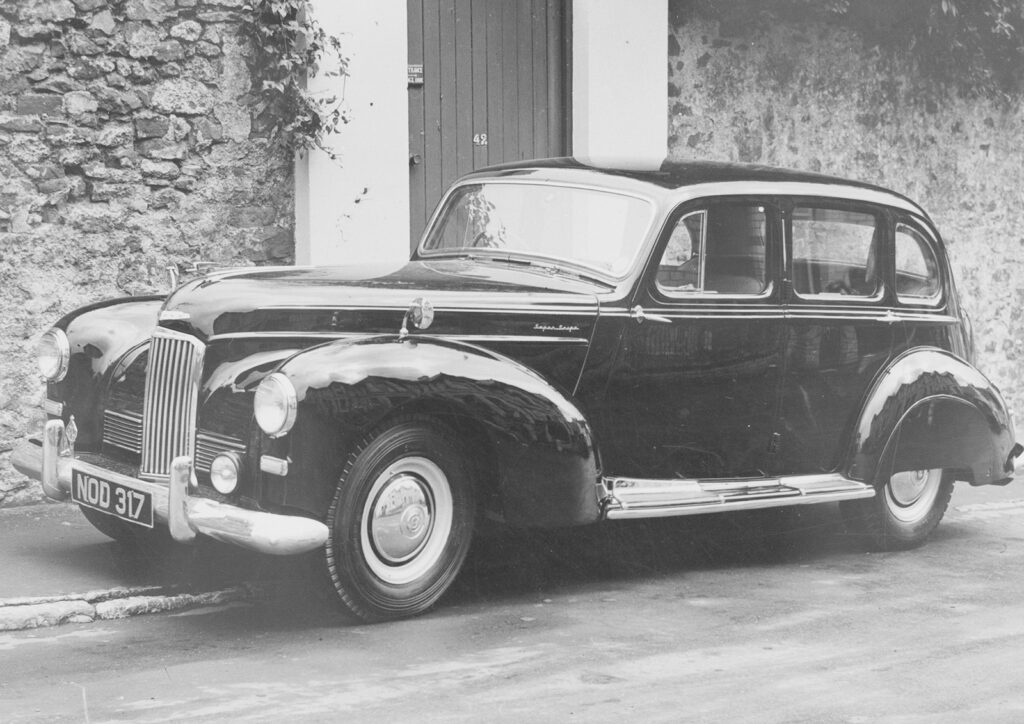
William Lavender’s Car on Fore Street in front of Clanage House
As a young girl Viv Wilson was a frequent visitor to the garage, spending holidays and weekends with her Aunt Daisy, Uncle Bill and Aunt Amy. Later on, Viv moved to live in the village and is well remembered for her regular articles covering Bishopsteignton life and its people, past and present which appeared for many years in the Teignmouth Post.
Bill and Daisy were great supporters of the local Bowling club with Bill regularly playing match games. They were much missed when in 1958, they and Amy moved to Embankment Garage, situated at the end of the bridge in Shaldon.
In 1958 Richard (Dick) and Edna Ward became the proprietors of Central Garage, they had moved from Lincolnshire with daughters Christine and Diane. They both went to Teignmouth Schools, Christine at the Grammer and Diane at West Lawn Secondary. Their brother Patrick was born soon after their move to Bishopsteignton.
In 1958, Colin Back started working on Saturdays, serving petrol and paraffin, he then became full time on leaving school in 1959 and took over invoicing as well as general duties front of shop. Alan Heard continued for a short while, to work part time at the garage. and George Ware who lived on Radway Hill, joined the team as a full-time mechanic. Dick brought with him his expertise in agricultural machinery.
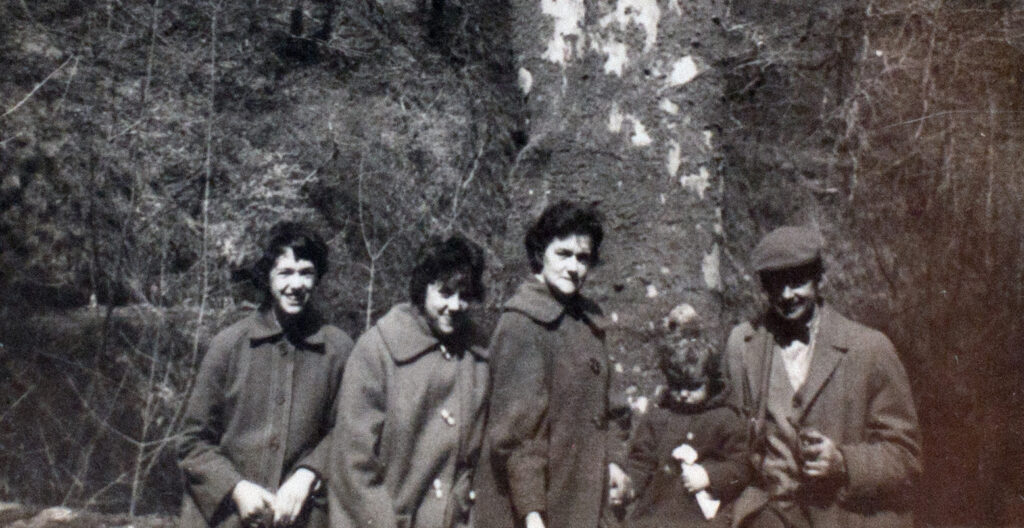
Edna and Richard Ward (Owners of Central Garage with their children Christine, Diane, Patrick
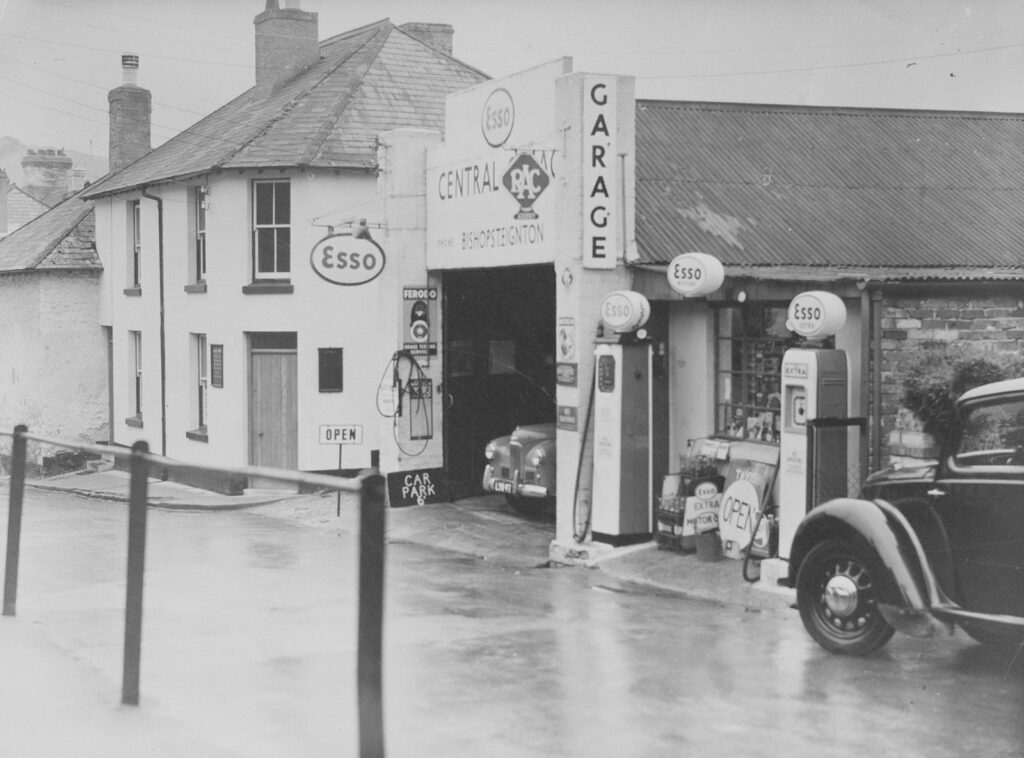
Central Garage 1958 when Mr and Mrs Ward were the owners
Richard, Edna and family left Bishopsteignton in 1961 and moved to North Devon before emigrating to Australia two years later.
It was in 1961 that George and Mabel Codling took over the Central Garage having recently moved back to England from Bullawayo in Zimbabwe. George Ware and Colin continued to work at the garage, for a short time and in 1966 George and Mable Codling retired and moved to Murley Crescent.
Malcolm Rawlings, formerly from North Devon and his wife Margaret originally from Oxfordshire had lived in Gloucestershire for a short time. It was from there that on 1st April 1966 they started out on a new adventure, when they moved to Bishopsteignton and became the proprietors of Central Garage. It was here that Barry Margary and Jim Sanders joined their team.
They were a popular couple who soon became immersed in many aspects of village life. Among other groups, Margaret was a great supporter of Sheila Robbins and Jane Caldwell who started the children’s theatre. At one stage, Malcolm became chairman of the ‘Carnival Committee’.
On 31st May 1987, after 21 years at the garage, Malcolm and Margaret retired but to the delight of their many friends, business and social connections they remained in Bishopsteignton and moved to Littlefield from where they continued their links with village life.
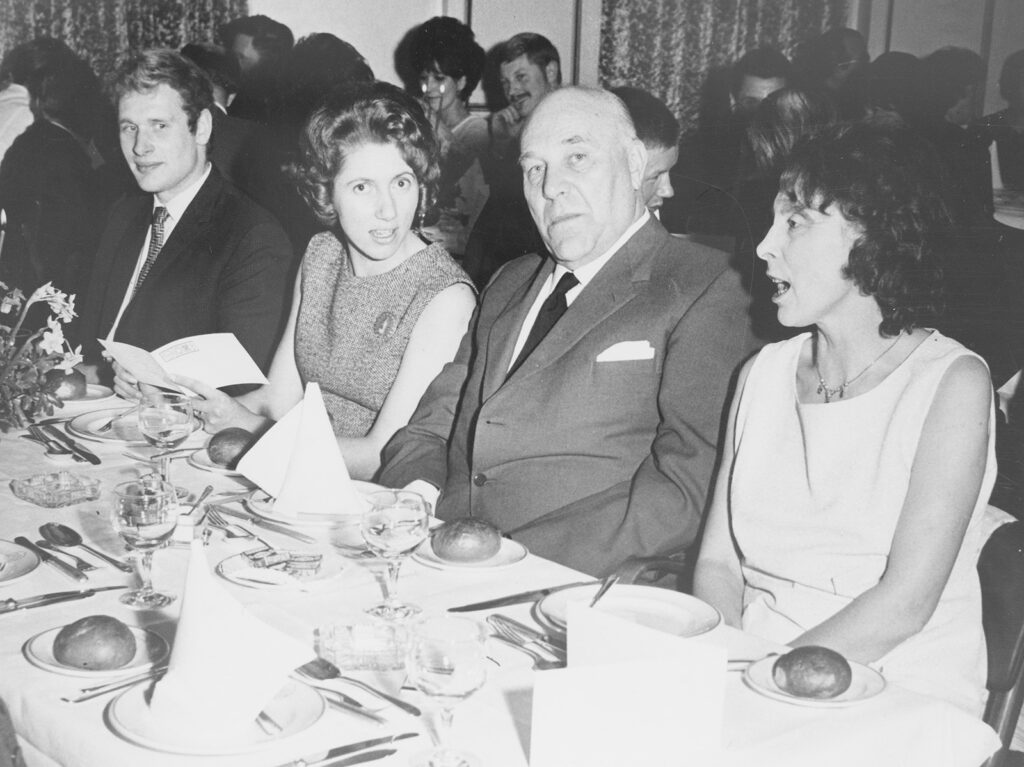
Margaret Rawlings with former owners of Central Garage Amy Arscott and Bill Lavender.
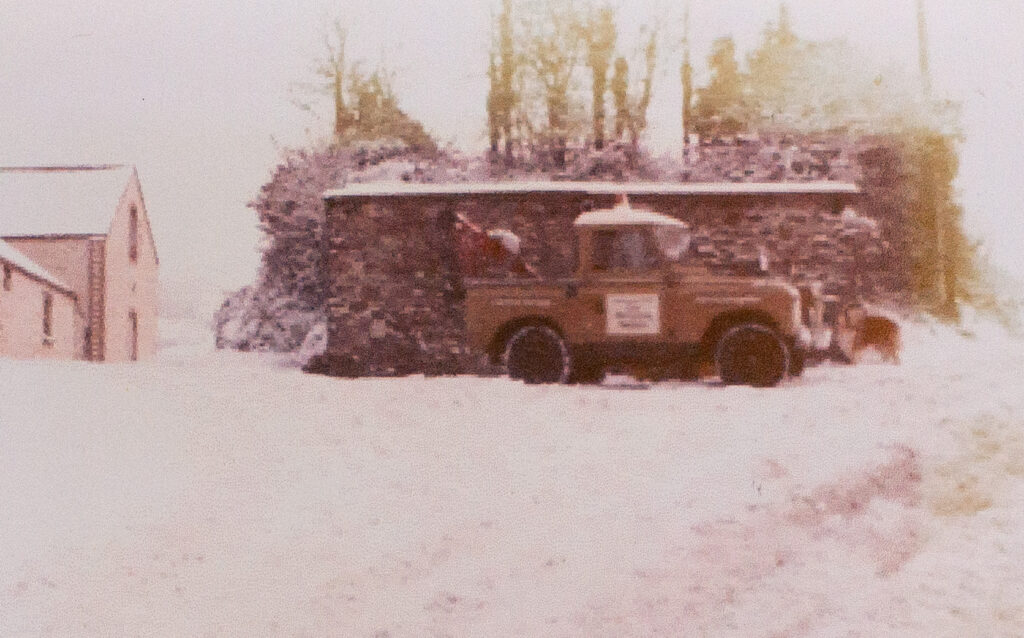
Central Garage recovery landrover in the snow
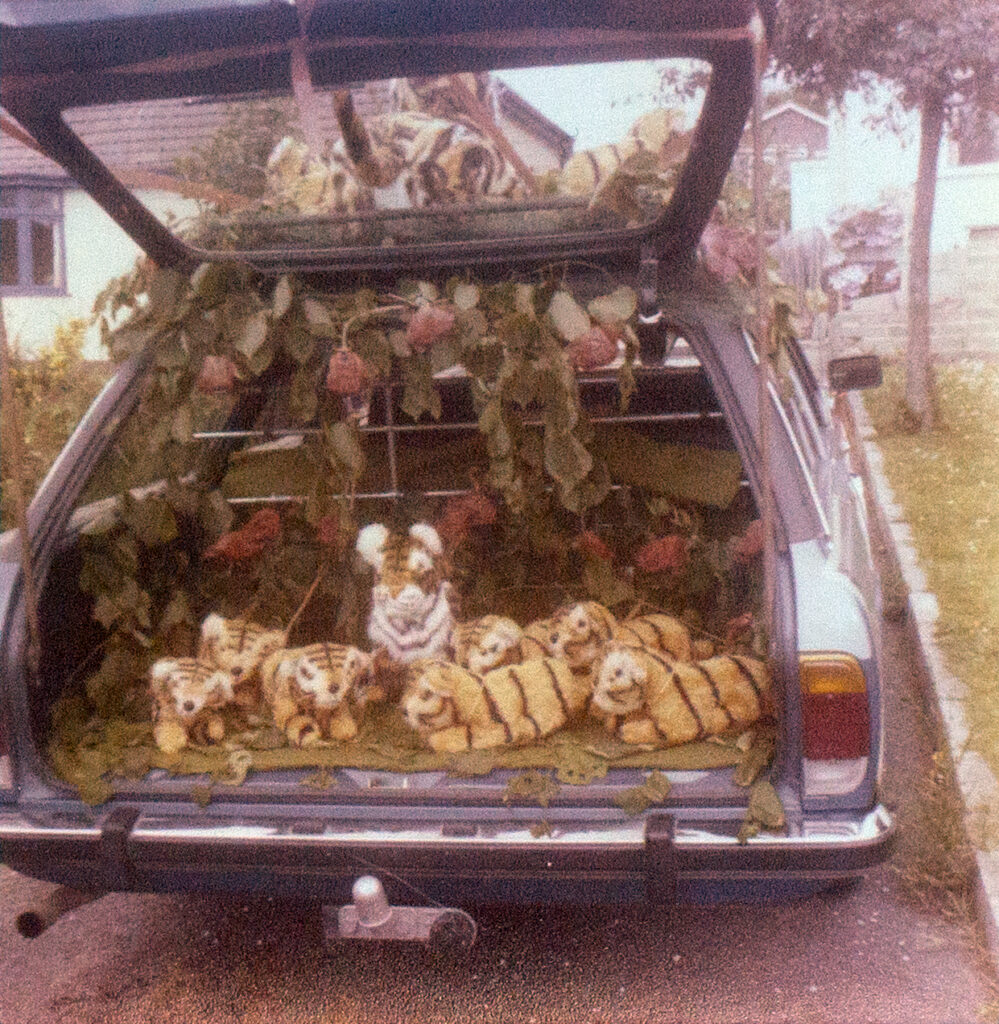
Car belonging to Malcolm Rawlings dressed for a carnival with Esso tigers as part of the “Save Our School” campaign
On 1st June 1987 Central Garage came under the new ownership of Graham and Suzanne Nicholson, who employed Jackie Forte, who is well known by many in the village, from about 1996.
Jackie continues to work for the current owner Rob McGinn who took over Central Garage in August 2020. Rob is a popular local businessman and lives in Bishopsteignton. He has historical roots in the street, where he now runs his garage business. It was in Fore Street that his grandparents and great grandfather on his mother’s side, raised their families.
I am sure there is much more to still learn about this lovely old building and the people that have been associated with it over the past 200 plus years of housing and looking after an evolution of vehicles.
Central Garage is just one of the many historic buildings to be found in Fore Street.
Acknowledgements
With thanks to: Margaret Rawlings, Viv Wilson, Jackie Forte, Rob McGinn, Gary Aldridge.
